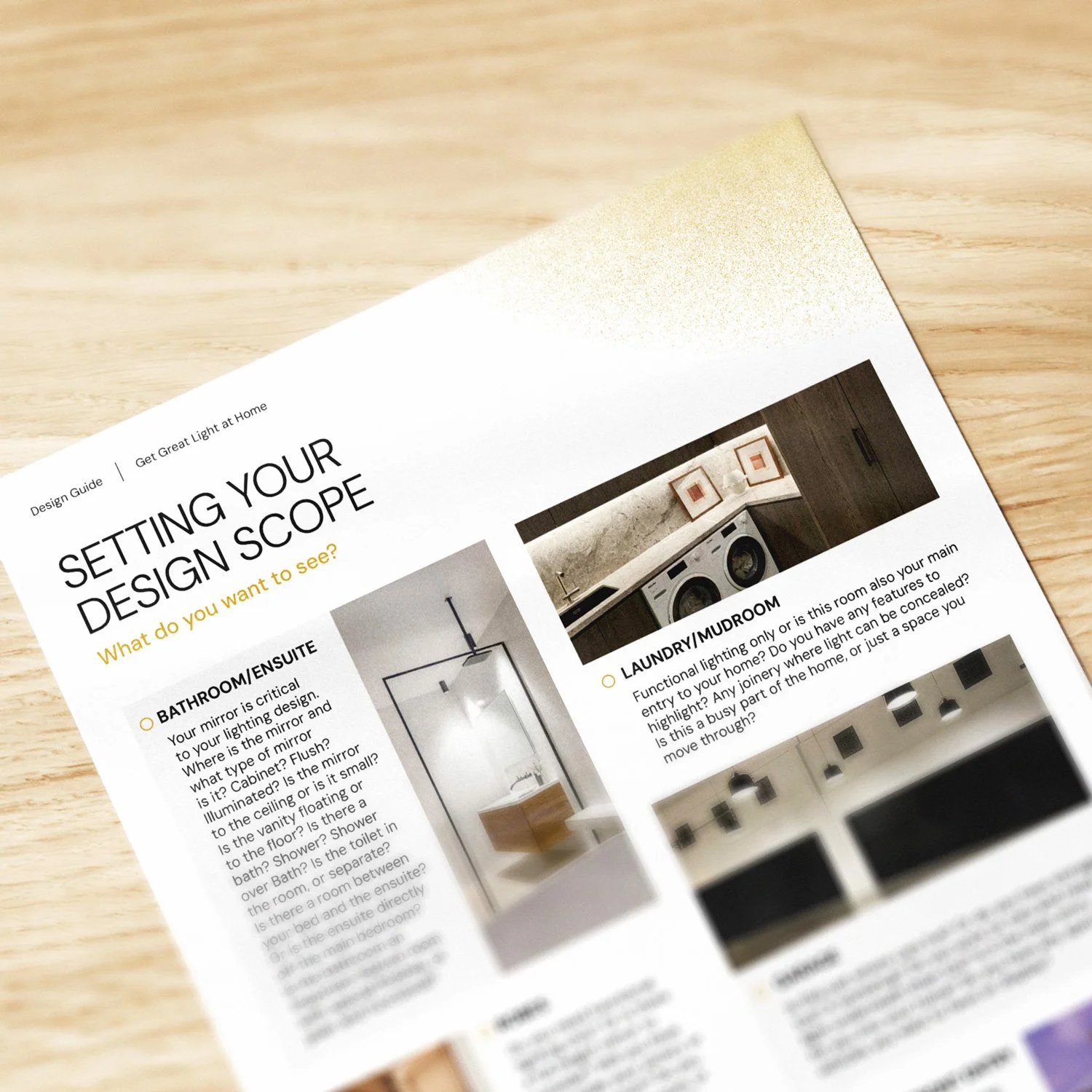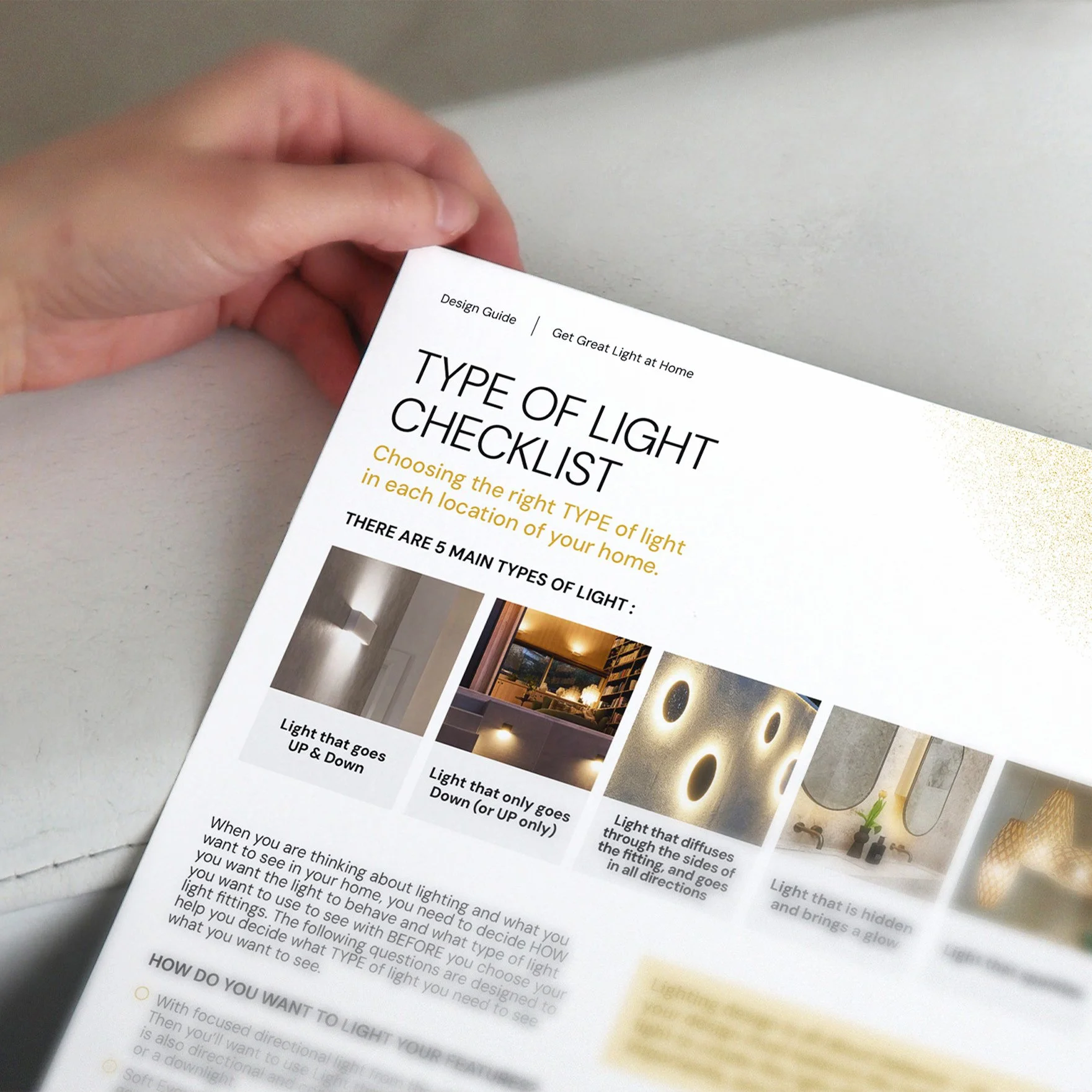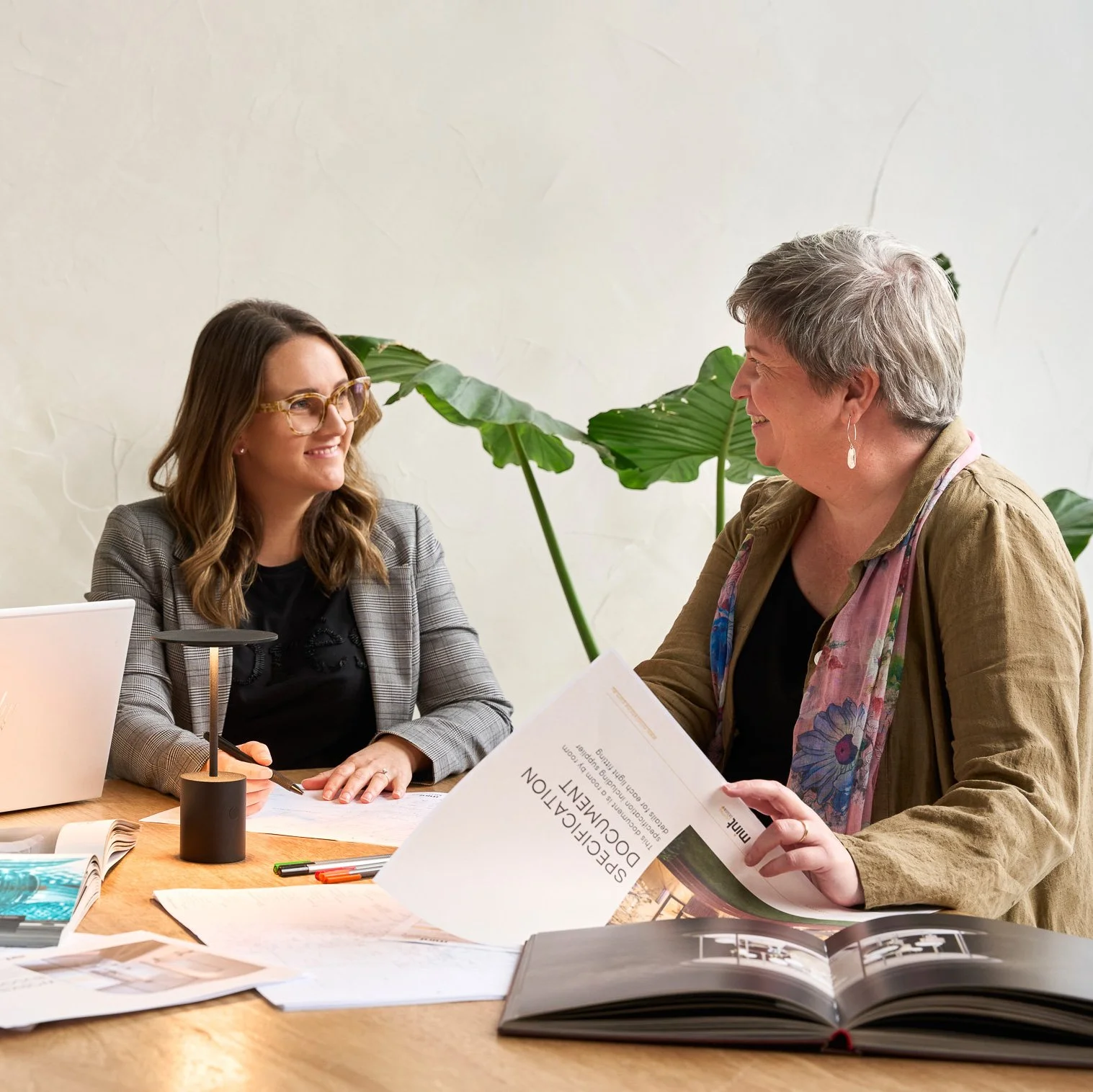
GET GREAT LIGHT AT HOME
Design Guide by MINT Lighting Design
Create your own Lighting Plan room by room and make informed choices for the light in your home.
Lighting decisions can feel overwhelming - but they don’t have to be.
The MINT Lighting Design Guide is a concise, practical resource that gives you a structured, way to plan lighting for your home - even if you’ve never thought about lighting design before.
Whether you’re renovating, building, or just want to fix lighting that doesn’t feel quite right, this guide gives you the prompts, strategies, and design logic you need to get it right.
What Is the Design Guide?
A 10-page guide including a step-by-step design process written by lighting expert Adele Locke, designed to help you work through your lighting decisions. It walks you through every room of your home, helping you think about them from the point of view of a lighting designer giving you the tools to plan a space that looks good, feels great, and functions well.
You don’t need a design background. You don’t need to know lighting lingo.
You just need this guide, a pen, and a willingness to ask:
“What do I want to see?”
This Guide Is Perfect for you If:
You’re building or renovating and want to make better lighting decisions
1
You feel unsure how to talk to your electrician, architect, or builder about lighting
2
You’re frustrated by being told you have to have downlights everywhere
3
You want to plan lighting that enhances your materials, furniture, art, and finishes
4
You’ve watched Light School and are ready to apply what you learned
5
You are an interior designer or design professional looking for a new approach to lighting in your projects
6
You’re an electrician with a wealth of site experience but looking for practical advice on how to light homes without relying on downlights everywhere
7
What’s Inside the Guide?
Each page is filled with practical prompts, checklists and real-world context to help you see your home like a lighting designer.
Guided Room-by-Room Prompts
✓ Entry: Plan first impressions, focal points, and mood
✓ Kitchen: Define your zones: cooking, hosting, tasks, and joinery lighting
✓ Living & Dining: Multi-use lighting for comfort, creativity, and flexibility
✓ Bedrooms: Identify lighting needs: calm retreat or active space?
✓ Bathrooms & Ensuites: Consider mirror types, feature tiles, vanity style
✓ Hallways & Stairs: Plan for safety, flow and showcasing architecture
✓ Powder Rooms: Create dramatic or quiet moments
✓ Garage, Laundry & Mudroom: Balance function with aesthetics
✓ Façade & Outdoor: Plan for security, and nighttime impact
BEFORE YOU START
Key Planning Considerations
How furniture layout affects lighting needs.
What your materials, finishes, and colours mean for light behaviour.
Ceiling heights, bulkheads, and features that impact fitting choices.
Special needs: vision, glare sensitivity, and accessibility.
Where ceiling fans and HVAC systems may create constraints.
10-Step Lighting Design Process
Within the guide, you’ll find a simple, sequential lighting workflow:
Define what you want to see in each room
Choose types of light: uplight, downlight, concealed, sparkle
1
2
Sketch a basic schematic lighting plan
Select appropriate light fittings for function and effect
3
4
Plan your switches, dimming, and control systems
5
Document your selections and prepare for trade coordination
6
Use this plan to confidently brief your electrician, cabinetmaker or designer
7
Luminaire Selection Checklist
At the end of the guide, you’ll find a clear, practical breakdown of how to choose the right LED light fittings - without needing an engineering degree.
This section helps you confidently interpret technical terms and cut through the jargon so you can select fittings that work for your home.
You’ll learn how to evaluate:
✓ Beam angles (and what’s best for different rooms)
✓ CRI (Colour Rendering Index) for rich, natural colours
✓ Lumen output for different lighting effects
✓ Glare ratings (UGR) to ensure comfort
✓ Colour temperature (CCT) and how it influences mood
✓ IP ratings for bathrooms and outdoor zones
✓ What to ignore - and what really matters when comparing LED fittings
This checklist gives you the confidence to navigate online stores, lighting showrooms, or electrician recommendations with clarity and purpose.
Real-life Benefits
Stop second-guessing your lighting decisions.
Design lighting that works with your layout and lifestyle.
Improve your comfort, safety, and mood - without over-lighting.
Save time and money by making the right choices the first time.
Communicate more clearly with professionals working on your home.
MEET THE LIGHTING DESIGNER
Created by Adele Locke
As the founder of MINT Lighting Design, Adele Locke has helped thousands of Australians understand how to see and shape light in their homes. With over 12 years of experience and membership in IESANZ and IALD, she brings both expertise and empathy to the lighting process.
This guide reflects her belief that great lighting design should be accessible to everyone.
TESTIMONIALS
“This little guide helped me sort out so many details I hadn’t even considered.”
“It’s like a roadmap through your own home - but through a lighting designer’s eyes.”
“I found the design guide and light school to be helpful in directing me to think about how I use my home and what I want to see.”
“I really want to say a very big thank you! The guide is fantastic, we have learnt so much.”

GAIN ACCESS
Get the Design Guide Now
Instant download (10-page PDF)
Yours to keep and reuse for future homes or projects
Designed to work beautifully alongside the Light School seminar
A$275.00
OR… BUNDLE & SAVE!
Get the Design Guide + Light School Bundle
Learn the principles of light through the seminar, then use the guide to apply them - room by room.
✓ Save with the bundle
✓ Ideal for homeowners ready to plan with clarity and confidence
✓ Recommended first step before meeting your builder or electrician
FAQs
-
The guide comes in digital PDF format. Once you’ve clicked “Add to Cart” and gone through the checkout process, you’ll be able to download the guide. You can then save it on your computer and access it anytime.
-
You’ll be able to read the guide on any device that supports PDF files. That includes desktop computers, laptops, tablets and smartphones.
-
Yes, once you’ve purchased the guide, you may print it out for your own use.
-
Access to this Design Guide is personal, meaning that only the person who purchased it can access it and watch it. If you know someone who would find this guide helpful, please link them to this page so that they can find out more about the it and, if they're interested, purchase access.
Please Note
The content in this document is owned by MINT Lighting Design and your purchase of this document does not give you the right to use/redistribute/re-make or in any other way use this content as your own, or for your business or for any other commercial or non commercial purpose. If you are an educator and want to use this document for your students, reach out to MINT Lighting Design directly to arrange the permissions needed.
MINT Lighting Design is not legally responsible if this resource doesn’t give you the results it’s given other people. This educational resource is a guide to assist you in thinking differently about light and lighting design. It does not constitute professional advice, nor does it guarantee that a lighting design created using this guide will be effective or compliant.
MINT Lighting Design is a professional team of designers who are very experienced and excellent at what they do. Our clients enjoy amazing results from working with our team. We are delighted to share what we know in this, and other educational content for you to enjoy however we trust that you understand that our many decades of experience can not be captured in one document, and that any educational content we provide is to help you gain a greater understanding of light and lighting design – and will not make you a qualified professional in this field, nor will it guarantee that you can create your own lighting design. The results you achieve from using this guide will depend on a combination of factors we have no control over such as your experience in construction and design, the effort you put in and the advice you take from other parties.
Your implementation of the suggestions set out in this resource does not create a professional relationship between you and MINT Lighting Design. If you want feedback or advice about your specific project, our professional team would be delighted to help – please reach out to discuss which of our design services will help you achieve your lighting goals.

















